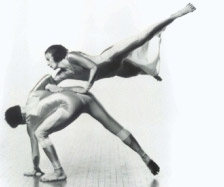
| HOME |
| NERVE |
| REVIEWS |
| ARCHIVE |
| EVENTS |
| LINKS |
| ABOUT US |
| CONTRIBUTORS |
| BACK ISSUES |
| CONTACT US |
 Trisha
Brown Dance Company
Trisha
Brown Dance Company
Presented by Liverpool Culture Company
Liverpool Playhouse (7th June 2006)
Reviewed by Amanda DeAngeles
The production credits highlight support from over fifteen organisations - funds, academies, and companies - you catch my drift. This North American dance company must spend most of its time completing applications for support.
“Company members have kindly been working with Merseyside Dance Initiative to deliver a programme of workshops for Liverpool schools and dance artists”. Nerve would like to hear your comments if you took part in a workshop.
The fortunes of this beautiful theatre have definitely turned around since financial loss threatened closure a couple of years ago. So, before I give you a flavour of the performance, I pose a question: would Liverpool Culture Company and the Playhouse support LOCAL dancers, actors and artists, if they were to come forward? Have they already? Answers on a postcard to Nerve magazine.
Programme information: 'Trisha Brown is a widely acclaimed choreographer who began to present dance by using walls and even rooftops in the 1960’s & 70’s.' Where on earth did she get that idea?
Tonight’s programme was made up of three separate dance works:
Set and Reset (1983)
Two canvas 3-D pyramids bookend a rectangle you could use for camping.
Black and white newsreel is projected against this set, presented by Rauschenberg,
who also designed the dancers’ translucent, but not indecent attire;
chiffon fabric covered in newspaper print. Audio is nostalgic but historical
spoken reports are masked by Laurie Anderson’s tin-pot percussion
sound. The set was slowly raised so the dancers could enter the stage,
but the reel kept rolling. I felt it erroneous to overhang the 3-D canvas
as it was difficult to absorb the quickly changing snippets of historic-report
alongside dance performance. I tried several times, but I gave up. I hope
to see it again as a solo exhibit.
To commence, a dancer is carried by two others across the stage - above
their shoulders like a rolled-up carpet delivery. Carpet girl pretends
to walk as she seems to comfortably lie sideways in the air. A graceful
war then peace ensues and then other dancers take to the stage, all are
barefoot.
A shadowy death-like character walks across the rear of the stage while
dancers float their limbs. ‘Tin pot’ music is overlaid with
machine-gun-fire, briefly. The dance is faultlessly executed and with
most of the nine dancers on stage it’s rather like watching a slow-motion
ice-dance performance. “What do you see?” is a question repeated.
The movement of all nine is like water flowing steady from a fountain
but in lots of directions. I’m unsure as to how Laurie Anderson’s
score compliments this. The dance conveys a repetitive low emotion. I
wrote, ‘war, fear, industry, politics and death’ as a wordy
expression of this. Close contact in pockets of the stage area featured
throughout.
The first short solo performance is a male dancer, aesthetically pleasing
to the eye. He dances with power, but I think the choreography stilts
his showmanship. I think the same for other interspersed solo sections
with dancers alternated. As a troupe, dancers join and repeat motion,
twisting and winding around, on and through each other - validating an
'exploration of visibility and invisibility' described in the programme.
At the end of this dance I feel stunned: I was cheated out of more excitement!
It was void of passion. A careful assemblance of building blocks not building
anything. There was little conviction from the dancers who seemed rather
bored or loathe do to more than present the dance. The music and film
reel failed to assist.
Present Tense (2003)
A change of set to a child-like painting in primary colours, gave a more
conventional backdrop and a refreshing change from black and white. The
3D canvas has gone.
Turns and lifts dominate what seems like a game of Twister in places.
The music is still tin-pot percussion but introduces an oriental twang
instead of an archaic news broadcast.
I wrote, ‘banishment, sexual tension, predatory, defeat, search
and venom’, as a reflection of this visual performance. The dance
equates to geometry forms: shape, numbers or letters. The lifts in this
section had more vivre but aside from that the moves were natural ones
most people can make. The conundrum of choreography is what makes it so
different. One dancer walked across the other dancers’ thighs -
this was a highlight I wanted to applaud, but nobody did. Physical expression
was hampered by lack of passion in the music. It was confusing. I’ve
seen more energy in street performance.
Groove and Countermove (2000)
Stringed instrumental music turned to modern jazz with brass and a lovely
cello insert with far more passion. A bright stage with a white backdrop
including 24 rectangular shapes displayed lines and doodles in each. The
symmetry and chaos of the set was worthy of its own art space. The dancers
were dressed in a rainbow of uniforms and it was then I noticed some of
the dancers had bodies - rather than just bones. There seemed to be no
principle dancers.
To sum up I told you already. However, to make this contemporary meaning
‘now contemporary’ it requires occasional acrobatic skill
and someone to re-arrange the music with some electronica beat.
I never heard a single “More”, “Bravo” or “Excellent”
during the lengthy curtain call. It was a pretentious performance with
value as entertainment only to students of dance and artists who study
form.
Dancers: Neal Beasley, Sandra Grinberg, Hyun Jin Jung, Leah Morrison, Brandi L Norton, Cori Olinghouse, Stacy Matthew Spence, Todd Lawrence Stone, Katrina Thompson Warren and Gwen Welliver.
Printer friendly page